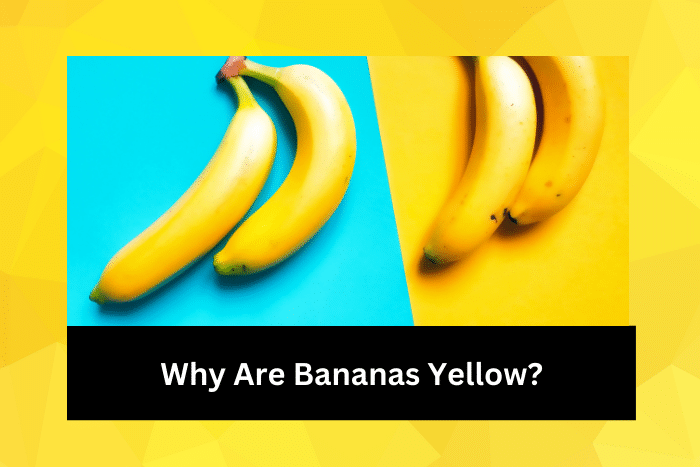Have you ever been dazzled by the bright color of your favorite snack and wondered why bananas are yellow?
And why is the fruit inside a different color?
Is it true that not all bananas are yellow?
And, of course, it changes color from green to yellow, then brown or black.
Why does that happen?
Are bananas safe to eat if they are not that familiar bright yellow color?
Let’s explore some colorful banana science!
A banana is green when it first reaches maturity and is ready to be harvested. The green color comes from the presence of chlorophyll, which is a molecule essential in the photosynthesis process. As a banana ripens, it produces ethylene gas that reacts with the acids in the fruit, and this, in turn, breaks down the green chlorophyll. Eventually, the green color is replaced by yellow, signaling that the banana is perfectly ripe. A further color change occurs when the banana overripens and produces more ethylene causing the yellow peel to decay and become brown. The final stage is when the banana rots and turns black.
Why Does a Banana Change From Green to Yellow?
When you pop to the store to buy your bananas, they will typically be green in color and not so nice to eat.
The green hue indicates chlorophyll.
This is a molecule that is necessary for photosynthesis to work and supply nutrition to the banana plant.
Bananas are usually harvested when they are green to allow for the time spent in transportation.
They are not yet fully ripe at this stage.
If the bananas were already ripe when they left the plantation, then they would not be fit to eat when they reached the supermarket.
When a banana is green, it is actually more acidic than sweet.
As the banana ripens, it emits ethylene gas, and this reacts with the acids causing them to break down, producing sugar.
The chlorophyll is also affected by the ethylene gas, and the pigments are replaced by the familiar yellow color.
This change in color indicates the banana is ripe, ready to be eaten, and will be sweet and delicious.
And the inside of the banana lacks chlorophyll or other chemicals and is, therefore, white.
Why Do Bananas Go Brown and Black?
I am sure that you have noticed that once a banana has turned yellow, it doesn’t take long for it to start going brown.
Again this is due to the continued production of ethylene gas.
All fruits produce this gas, but bananas more so than others.
The first sign that a banana is becoming overripe is the presence of brown spots on the peel.
This indicates that the skin is starting to decay.
This natural process is called enzymatic browning and can’t be stopped, even by freezing the fruit.
If some bananas go brown quicker than others from the same bunch, it could be because they are bruised or damaged in some way.
Bruising causes the banana to produce even more ethylene and will speed up the ripening process.
The final stage is when the banana turns black.
The fruit is now rotten and should not be eaten!

Can Bananas Be Different Colors?
Although the majority of commercially produced bananas are yellow, it is possible to find other colors.
These are more likely to be found in independent stores and imported by smaller plantations.
Some of the more common colors are red, pink, blue, and purple.
(For further fascinating information about blue bananas, click the link below this article.)
And it’s not just the peel that can be a different color.
Red bananas, which typically originate from the West Indies, also have pink fruit inside.
The Karat banana is very odd and is not even a familiar curved shape.
The fruit is orange and has a hint of strawberry flavor.
Essentially, the different colors indicate certain chemicals are present in the fruit.
Why Do Bananas Change Color?
Final Thoughts
Bananas start off green and change to a yellow color as they ripen.
The initial green color is caused by chlorophyll that breaks down as the banana ripens and produces ethylene gas.
Continued ripening turns a banana brown and then black.
Not all bananas are yellow, other colors can be found.
Just remember that a green banana is not ripe, a yellow fruit is perfect, and a black peel indicates the fruit is rotten!
But what about other colors? Are some bananas blue due to genetic modification?
